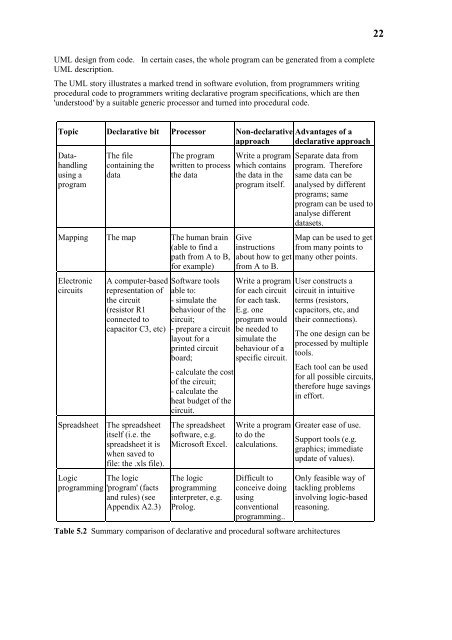pdf: 600KB - Potsdam Institute for Climate Impact Research
pdf: 600KB - Potsdam Institute for Climate Impact Research
pdf: 600KB - Potsdam Institute for Climate Impact Research
Create successful ePaper yourself
Turn your PDF publications into a flip-book with our unique Google optimized e-Paper software.
22<br />
UML design from code. In certain cases, the whole program can be generated from a complete<br />
UML description.<br />
The UML story illustrates a marked trend in software evolution, from programmers writing<br />
procedural code to programmers writing declarative program specifications, which are then<br />
'understood' by a suitable generic processor and turned into procedural code.<br />
Topic Declarative bit Processor Non-declarative<br />
approach<br />
Datahandling<br />
using a<br />
program<br />
The file<br />
containing the<br />
data<br />
The program<br />
written to process<br />
the data<br />
Mapping The map The human brain<br />
(able to find a<br />
path from A to B,<br />
<strong>for</strong> example)<br />
Electronic<br />
circuits<br />
Spreadsheet<br />
A computer-based<br />
representation of<br />
the circuit<br />
(resistor R1<br />
connected to<br />
capacitor C3, etc)<br />
The spreadsheet<br />
itself (i.e. the<br />
spreadsheet it is<br />
when saved to<br />
file: the .xls file).<br />
Logic The logic<br />
programming 'program' (facts<br />
and rules) (see<br />
Appendix A2.3)<br />
Software tools<br />
able to:<br />
- simulate the<br />
behaviour of the<br />
circuit;<br />
- prepare a circuit<br />
layout <strong>for</strong> a<br />
printed circuit<br />
board;<br />
- calculate the cost<br />
of the circuit;<br />
- calculate the<br />
heat budget of the<br />
circuit.<br />
The spreadsheet<br />
software, e.g.<br />
Microsoft Excel.<br />
The logic<br />
programming<br />
interpreter, e.g.<br />
Prolog.<br />
Write a program<br />
which contains<br />
the data in the<br />
program itself.<br />
Give<br />
instructions<br />
about how to get<br />
from A to B.<br />
Write a program<br />
<strong>for</strong> each circuit<br />
<strong>for</strong> each task.<br />
E.g. one<br />
program would<br />
be needed to<br />
simulate the<br />
behaviour of a<br />
specific circuit.<br />
Write a program<br />
to do the<br />
calculations.<br />
Difficult to<br />
conceive doing<br />
using<br />
conventional<br />
programming..<br />
Advantages of a<br />
declarative approach<br />
Separate data from<br />
program. There<strong>for</strong>e<br />
same data can be<br />
analysed by different<br />
programs; same<br />
program can be used to<br />
analyse different<br />
datasets.<br />
Map can be used to get<br />
from many points to<br />
many other points.<br />
User constructs a<br />
circuit in intuitive<br />
terms (resistors,<br />
capacitors, etc, and<br />
their connections).<br />
The one design can be<br />
processed by multiple<br />
tools.<br />
Each tool can be used<br />
<strong>for</strong> all possible circuits,<br />
there<strong>for</strong>e huge savings<br />
in ef<strong>for</strong>t.<br />
Greater ease of use.<br />
Support tools (e.g.<br />
graphics; immediate<br />
update of values).<br />
Only feasible way of<br />
tackling problems<br />
involving logic-based<br />
reasoning.<br />
Table 5.2 Summary comparison of declarative and procedural software architectures
















